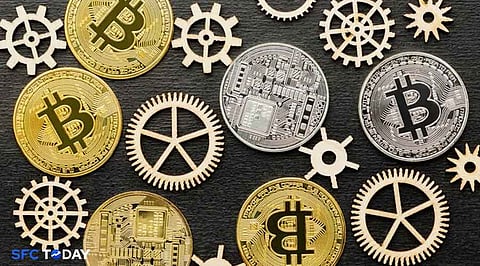

Long-Term Crypto Predictions (2024 – 2030) – Cryptocurrencies have firmly established themselves as a transformative force in global finance and technology. Recent trends, including regulatory developments, institutional interest, and technological advancements, have created a robust foundation for predicting their trajectory from 2024 to 2030. Here's a detailed long-term outlook for major cryptocurrencies like Bitcoin (BTC), Ethereum (ETH), Cardano (ADA), Solana (SOL), Binance Coin (BNB), XRP, and Dogecoin (DOGE), supported by the latest data and news.
Bitcoin is trading at $95,608, experiencing a 3.25% gain in 24 hours, driven by sustained ETF inflows. The recent $103 million inflow into Bitcoin ETFs, as reported by Sosovalue, reflects institutional confidence.
Bitcoin is likely to maintain its position as a hedge against inflation and a store of value. The 2024 halving event will reduce block rewards, further limiting supply and potentially triggering another bull run. Enhanced adoption by corporations, such as Tesla and MicroStrategy increasing their Bitcoin holdings, will bolster demand.
Predicted Range by 2026: $120,000–$180,000
Key Drivers: Bitcoin ETFs, halving effects, and adoption in emerging markets for remittances.
The scarcity induced by halvings will solidify Bitcoin's "digital gold" narrative. Its role as a reserve asset in developing economies could gain traction, especially as fiat currencies face devaluation pressures in certain regions.
Predicted Range by 2030: $300,000–$500,000
Risks: Regulatory pressures from developed nations and competition from other digital assets.
Ethereum is trading at $3,601, reflecting a 5.95% daily gain. Ethereum's dominance in DeFi (67% of total value locked) and NFTs (82% market share) continues to attract institutional and retail interest.
The full implementation of Ethereum's 2.0 roadmap, including sharding, will significantly enhance scalability and reduce gas fees. Layer 2 solutions, such as Optimism and Arbitrum, are already handling significant transaction volumes, alleviating congestion on the main chain.
Predicted Range by 2026: $6,000–$10,000
Key Drivers: DeFi expansion, NFT growth, and enterprise blockchain adoption.
Ethereum's leadership in smart contracts and decentralized applications (dApps) will continue. Collaborations with global corporations to develop private blockchains for supply chain, finance, and healthcare will add value.
Predicted Range by 2030: $15,000–$25,000
Risks: Emergence of competing blockchains and scalability challenges.
Cardano is trading at $1.01, after breaking resistance levels. The recent deployment of its Hydra scaling solution has enhanced its capacity for transactions, positioning it as a scalable alternative to Ethereum.
Cardano's partnerships with governments in Africa for identity solutions and blockchain-based record-keeping will strengthen its real-world utility. Its peer-reviewed approach ensures robust security and reliability.
Predicted Range by 2026: $3.00–$6.00
Key Drivers: Growth in decentralized governance and integration with IoT devices.
By 2030, Cardano could dominate industries requiring sustainable blockchain solutions. Its low energy footprint aligns with the global push for eco-friendly technologies.
Predicted Range by 2030: $10.00–$20.00
Risks: Slower adoption pace and competition from other Layer 1 protocols.
Solana is trading at $238.71, benefiting from its ability to process over 50,000 transactions per second (TPS). Despite network outages earlier this year, its ecosystem for gaming and DeFi continues to grow.
Solana's focus on decentralized gaming and NFT platforms will drive adoption. Partnerships with gaming studios and Web3 projects are expanding its utility.
Predicted Range by 2026: $400–$700
Key Drivers: Adoption in gaming and DeFi, and improved network reliability.
With advancements in network security and scaling, Solana could emerge as a major competitor to Ethereum for high-speed decentralized applications.
Predicted Range by 2030: $1,000–$2,000
Risks: Dependence on centralized validators and potential regulatory scrutiny.
BNB is trading at $658.15, up 2.17% in 24 hours. It remains central to the Binance Smart Chain (BSC), which has seen increased usage in DeFi and token launches.
As Binance expands its ecosystem, including ventures into decentralized exchanges (DEXs) and tokenized stocks, BNB's demand will grow. The planned quarterly token burns will continue reducing supply, driving scarcity.
Predicted Range by 2026: $1,000–$1,500
Key Drivers: Binance Smart Chain growth and staking incentives.
BNB could become a widely used asset across multiple financial platforms, particularly in emerging markets where Binance dominates.
Predicted Range by 2030: $2,500–$4,000
Risks: Regulatory action against Binance in key jurisdictions.
XRP is trading at $1.48, buoyed by Ripple's legal victory against the SEC. Partnerships with financial institutions for cross-border payments remain a key strength.
Ripple's expansion into emerging markets for low-cost remittances will sustain XRP's growth. Its On-Demand Liquidity (ODL) product is gaining traction among banks.
Predicted Range by 2026: $4.00–$8.00
Key Drivers: Adoption in global remittances and real-time settlement systems.
By 2030, XRP could become a preferred solution for international trade finance, given its speed and cost advantages.
Predicted Range by 2030: $12.00–$20.00
Risks: Ongoing legal challenges and CBDC competition.
Dogecoin is trading at $0.40, supported by its integration into microtransactions and tipping systems on platforms like Twitter.
Dogecoin's utility as a payment method and its vibrant community will sustain its relevance. Partnerships for retail payments could emerge as a growth driver.
Predicted Range by 2026: $0.80–$1.50
Key Drivers: Social media integration and microtransaction use.
If Dogecoin solidifies its role in micropayments and retail, it could transition from a speculative asset to a practical tool for daily transactions.
Predicted Range by 2030: $2.00–$5.00
Risks: Limited development and overreliance on community hype.
Institutional Interest: Bitcoin ETFs and Ethereum futures signal growing trust in crypto among institutions.
Regulatory Developments: Clarity from major economies like the U.S. and the EU will reduce volatility.
Technological Innovations: Layer 2 scaling solutions, zero-knowledge rollups, and blockchain interoperability will drive adoption.
Emerging Markets: Cryptocurrencies will see increased adoption in regions with high inflation or limited banking infrastructure.
The cryptocurrency market from 2024 to 2030 is poised for significant growth, driven by technological innovation, institutional adoption, and expanding use cases. While risks such as regulatory scrutiny and market competition remain, the long-term potential for major assets like Bitcoin, Ethereum, and Solana is undeniable. As the market matures, cryptocurrencies will increasingly become integral to the global financial ecosystem.